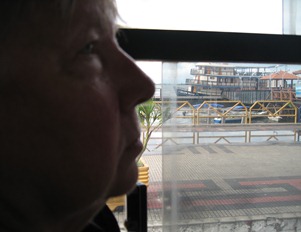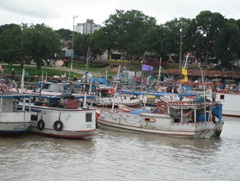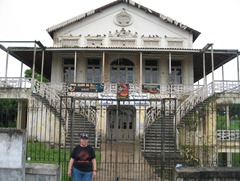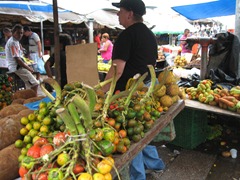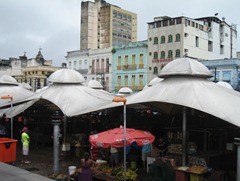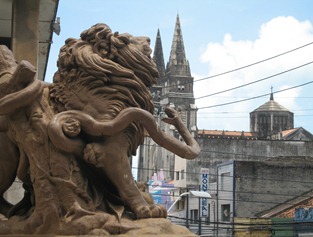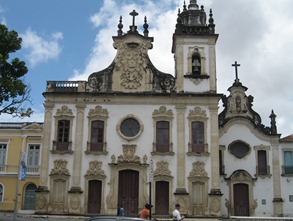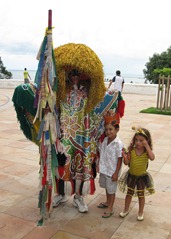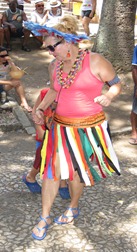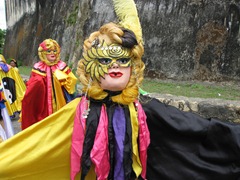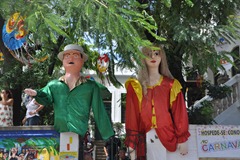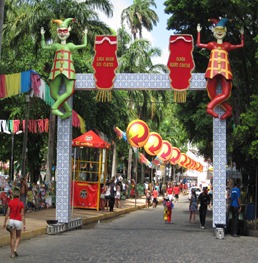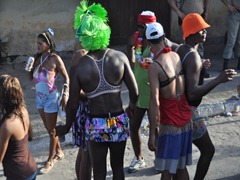Santarem, Brazil
After leaving Belem we sailed north around the Ilha de Marajo to reach the primary mouth of the Amazon river. The Amazon, of course, is the largest river system in the world by far. It emits more water into the ocean (46,000,000 gallons per second) than the next 7 largest rivers combined. Of its 15,000 tributaries, no fewer than 14 are at least 1000 miles long. At its widest point the Amazon is almost 35 miles wide, and its mouth is 250 miles wide. The Ilha de Marajo at its mouth is larger than Switzerland. So, through the next few days, the big thing to see (in size as well as importance and interest) is the river itself.
We entered the river early in the morning of Monday, February 27, and we crossed the equator going south in mid-afternoon. So pretty much all we saw that day was lots of river & rainforest.
The Amazon basin contains well over half of the Earth’s remaining rainforest, and it is shrinking (at the hands of human exploiters) at an average rate of more than 9,000 square miles per year. Between 2001 and 2010 an area of rainforest estimated to be about twice the size of Portugal was lost. The loss of this rainforest, which cannot grow back for hundreds of years once it is cut down, would have a large scale impact on the world’s climate (as if global warming weren’t scary enough).
On Tuesday, February 28, we came to Santarem, our first stop on the Amazon. It is a small city of a couple hundred thousand, and there really isn’t much to see there. Some people went on river excursions to fish for Piranha (they caught very few) or to a river resort nearby, but we decided just to walk through the town & see the river culture. The big thing to see here is called the “meeting of the waters.” This is where the blue Tapajos river & the muddy Amazon intersect & flow together for a number of miles before blending. You could see this from the ship but in Santarem they have built a small tower on top of a hill that gives a better view.
One of the publications on the ship invited us to see this “unique natural phenomenon.” However, since we will see another (supposedly more dramatic) meeting of the waters two days later in Manaus it is obviously not unique, just rare. But rare is still pretty good.
Santarem has the obligatory cathedral on a hill, a rather unusual blue one with a similarly painted gazebo across the street. But other than some brightly painted streets (which we have seen a lot in Brazil) there isn’t too much else. We did see an unusual statue of a parrot and we passed a statue of a turtle in the bus (but I couldn’t get a picture of it). So we got on the bus & went back to the ship.
February 29, 2012 | Categories: South America Circumnavigation | 2 Comments
Belem, Brazil
On Sunday, February 26 we came to Belem (Bethlehem), a city of a couple of million located on the Rio Para, southernmost branch of the mouth of the Amazon. Founded in 1616, Belem was the financial clearinghouse for the rubber industry that dominated the Amazon region in the late 19th & early 20th centuries.
Our ship was anchored a few miles down river, and the tenders dropped us at the village of Icoaraci. Village it may be but it had a (rather tumbledown) public library!
We were driven into Belem by a shuttle bus & dropped off at an old warehouse complex on the water that has been converted into shops & restaurants. It was a rainy day but there were nice views of the flowing river from behind the complex.
From there we walked to the Mercado Ver-o-Peso (“verify the weight market”). Begun in 1688, the name reflects the strict Portuguese taxes on everything entering or leaving Amazonia. In the market were live chickens, ducks & goats, as well as colorful fruits we had never seen before.
Not far away was the old port, which was crowded with the ubiquitous Amazon river boats, on which people live, sleeping in hammocks. Vultures & egrets patrol the port. The fourth picture below is a painting near the port, not a street.
Of course Belem has an elaborate cathedral, built in 1755, and there was a clock tower that does not look like Big Ben (but this time there was no claim that it does).
We visited the Forte de Presepio, erected in 1616 as the first building in Belem, but did not tour it since the signs are all in Portuguese. Here, and at many other places in Brazil, there were vendors selling coconuts, which are very popular.
Finally, there were several interesting mosaic sidewalks, quite different from what we saw in Rio.
It was Sunday in Belem so a lot was closed & there weren’t a lot of people out & about. We started to walk to the theater, about a third of a mile away, but we found ourselves on empty streets which made Mary uncomfortable, so we went back to the shuttle bus. We found out there that a woman from our ship had been attacked not far from the warehouse restaurants by a woman with a knife (who, we were told, had been sniffing glue, a problem in this city apparently). A couple of other passengers have been mugged in other cities (one right outside the dock in Recife). So maybe turning back from the empty streets was the correct move.
February 29, 2012 | Categories: South America Circumnavigation | Leave a comment
Fortaleza, Brazil
We arrived in Fortaleza (Fortress) on Friday, February 24. It is another big city (about 3 million) with skyscrapers lining its beachfront like Miami Beach.
I could think of only two reasons for stopping here: (1) its on the way, and (2) its our last docking port until we leave the Amazon, so we needed to fill up on water. A shuttle bus took us to the older part of town, but really it wasn’t much fun to walk around. Narrow, crowded sidewalks, lots of traffic, people set up all over the sidewalk selling stuff (and not interesting stuff) – altogether it was not a very pleasant city.
We saw two buildings of note. First was the Metropolitan Cathedral, a 20th century building that is the 3rd largest cathedral in Brazil. It is in a European style, with flying buttresses no less, and we were told it was inspired by the cathedral of Cologne (I have seen the cathedral of Cologne, & it is much more elaborate & beautiful than this one).
The other building was the Teatro Jose de Alencar (named after a 19th century Fortalezan writer). Approaching it on the street you see an ornate but fairly conventional Italianate (we were told) building.
But when you walk through to the inner courtyard you come upon the actual theater, which is made largely of iron in an Art Nouveau style.
It was a whimsical combination, which we enjoyed.
On our way back to the shuttle bus we walked through the Praca Jose de Alencar, where so-called comedians pass the hat and if you don’t put something in it you become the butt of some nasty jokes. Since we don’t speak Portuguese we decided to skip this entertainment, and we walked on through the Praca dos Martires (park of the martyrs) where there was statuary, fountains and a cooling canopy of trees (have I mentioned that in this part of the world it is HOT?).
___________________________-
UPDATE on Vitoria: You may recall (you can look back if you don’t) that we showed you a church in Vitoria dedicated to Our Lady Of The Good Death & speculated that there might be an interesting story behind that title. Since then, our friend Rita Reimer found the story & sent it to us to share with you:
The Sisterhood of Our Lady of the Good Death (Irmandade da Nossa Senhora da Boa Morte) is a small but renowned Afro-Catholic religious group in the state of Bahia, Brazil. Founded in the early 19th century as a Church-sponsored beneficent Sisterhood for female African slaves and former slaves, it became one of the oldest and most respected worship groups for Candomblé, the major African-based religion in Brazil. Presently reduced to about thirty members (from 200 or so at its height), most of them over fifty, it still attracts worshipers every year, especially at its August festival.
February 29, 2012 | Categories: South America Circumnavigation | 1 Comment
Cabedelo & Joao Pessoa
On Wednesday, February 22, we came to the port of Cabedelo, whose main claim to fame is that it is the starting point of the Amazon highway (several decades in the making but still far from complete). A fort was established here in 1589 to keep out the Dutch (not entirely successful). This is, as I understand it, the easternmost city in the Americas; it is closer to Africa than to southern Brazil, which we found a little mind-boggling.
Only two cruise ships a year stop at Cabedelo, which explains why we were greeted by a band at the dock as we left the ship. Cabedelo has some decent beaches.
Up the river, about a 40 minute bus ride, is the city of Joao Pessoa (John Person), another Brazilian city of a couple million people, established in 1585.
Fortunately, the old part of the city, which we visited, is not among these skyscrapers. It is a small area, but I don’t think I have ever seen so many churches per square yard. They were not needed to serve multiple denominations,since just about everyone here was Catholic, so it is puzzling that such a small town needed to be divided among so many churches. Some of them are very pretty, although with the damp climate there was a lot of mold. We were told that fighting the mold is a never ending battle. The one that seems predominant is the Convento Sao Francisco de Assis (not actually a church), which has a large courtyard and is supposed to have a beautiful ceiling inside, but we didn’t go in to see it (churches are not exactly novelties on this trip).
There were some colorful streets in the old town, but everything was closed up since it was still the morning after Carnaval. Of course it was also Ash Wednesday so we thought it odd that the churches weren’t open, but apparently religion isn’t really the central object of Carnaval any more.
We did find the Biblioteca (after much searching) but like everything else it was closed.
There were some mosaic sidewalks, but the design was much smaller than in Rio & it was done the easy way, with square tiles embossed with the wavy pattern. There was also some nice tile work on a number of the buildings.
As you saw earlier, however, most of the city was high-rise buildings. The highrise apartment buildings in this area are different from what you normally see in North America, in that they often have patterns of bright color & many of the windows are much smaller, presumably to help keep out the heat.
To end this post here is the last towel animal we have gotten (one of the best, though). We were told there would be water issues for the trip through the Amazon so they are trying to cut down on laundry and the first thing to go is the towel animals. You may recall this happened in Antarctica as well.
February 29, 2012 | Categories: South America Circumnavigation | Leave a comment
Recife & Olinda (day 2)
Tuesday, February 21, was the final day of Carnaval 2012. It was also the one day we were originally scheduled to be in Recife, and we had signed up for an excursion to Olinda, which is right next to Recife. While Recife is a large city of several million people Olinda is a small city with brightly painted buildings only a few stories high. It has been designated a UNESCO World Heritage sight.
We spent several hours walking around Olinda and although it was still late morning, already there were crowds in the street and the city was filled with costumed revelers. We saw several buildings of interest, but mostly we took in the city scenery & the people. Remember you can call up a label for a picture by moving your mouse over it; some labels are descriptive & some aren’t. Of course, there were churches.
There were colorful streets & marching bands.
A variety of people were dressed in costume, some of whom did performances (like the weird boxing pastiche in pictures 4 & 5).
We were told that in a neighboring town inland all the men wear costumes like the ones below so that the women of the town can’t tell who is who. It sounded pretty strange to us – obviously an opportunity for hanky panky – but then most of this stuff is at least a little strange to us.
Houses were decorated in a variety of colorful ways & people watched the passing show from their windows.
We saw some nice views of Olinda & Recife from the top of the hill near the Cathedral.
The Olinda Carnaval is known for its giant puppets, some of which are worn by people & some of which are used as decorations. I’m not sure what the story is behind them, but they are different. The first picture shows a person putting on the puppet costume of a popular Brazilian singer, and there is another puppet sitting in the window.
Now some miscellaneous pictures of Olinda for which I am too tired to think of categories. But the first one is here because Mary & I happened to be in it (just a little bit, on the lower right), & the second one is of an Olinda street the night before taken from the hill (we weren’t there, but its a nice picture).
Around noon we left Olinda & drove to Itamaraca Island where we were to have lunch near a beach. It took forever to get there because of snarled Carnaval traffic and it turned out that neither the lunch nor the visit was worth the lengthy bus ride. Anyway, here we are eating lunch (we are the last ones at the table, so look closely) & a view of the beach.
On the way back we passed through the fateful town where my camera was stolen. Here are a few pictures of the parade there, which I could have done without.
When we got back from the ill-fated trip we decided to walk over to the Recife Carnaval before dinner so that we would at least have a few pictures of Recife (we didn’t know yet that generous friends Patrice & Jeff would supply many more pictures). So the rest of the pictures here were taken by us; most are a little blurry because they were taken at night but it gives you an idea of what Carnaval in Recife was like. First we wanted to be sure to replace our pictures of the synagogue in the first blog posting and the Biblioteca in Recife (which were, of course, a little different because they are taken at night with a swirling Carnaval crowd):
Here is the main Carnaval stage, with a show going on.
Here is the secondary stage at the Recife Carnaval & the square in front of it.
There was a marching band & crowds, often in costume, everywhere.
One of the giant street decorations that we particularly liked was called Belle de Jour, and there was also one of the anonymous men like we saw in Olinda.
That evening there was a Carnaval celebration in the ship’s restaurant, in which all the waiters and other ship personnel dressed in special costumes (they do this often, for a variety of special & not-so-special occasions), as did some of the passengers. Then there was a show about Frevo, the local dance tradition (you may have seen the multicolored parasols used in this dance in several of the pictures). It wasn’t as good as the Samba shows (not even close), but it was interesting nonetheless. While I don’t have a picture of the waiters, there is a picture here of the cruise director in the Carnaval costume acting as host for the show.
And so ended a memorable visit to Recife & Olinda – it was the best of times and the worst of times. But we have gotten over the bad part by now and are just relieved that we still have all the pre-Recife pictures & movies and still have a camera with which to finish out the trip.
February 27, 2012 | Categories: South America Circumnavigation | Leave a comment














